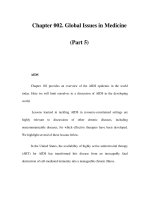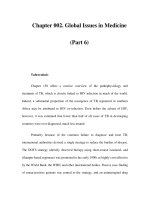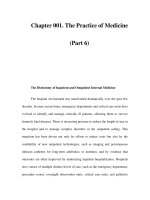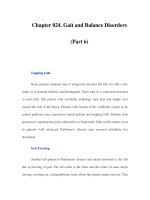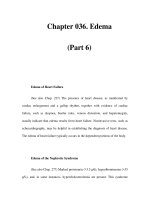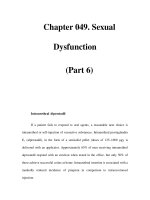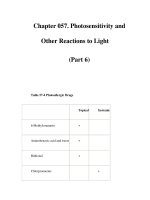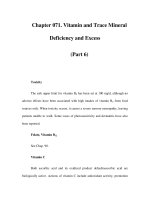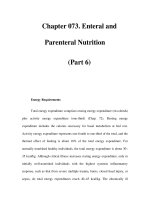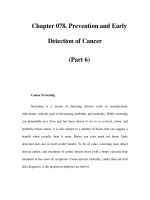100 Questions in Cardiology - Part 6 ppsx
Bạn đang xem bản rút gọn của tài liệu. Xem và tải ngay bản đầy đủ của tài liệu tại đây (130.43 KB, 24 trang )
abnormal blood pressure response during exercise. History of
multiple sudden deaths in the family is an important risk factor.
• Ambulatory monitoring of all patients with a diagnosis of HCM is
mandatory and this should be for at least 48 hours.
• Exercise electrocardiography is also mandatory. Patients with HCM
should undergo a metabolic exercise test with frequent blood
pressure monitoring (every minute during exercise and for 5
minutes during recovery). An abnormal BP response is an
important non-invasive marker of risk. The peak oxygen
consumption during the exercise also helps identify those with
significant limitation of exercise capacity.
• Non-sustained ventricular tachycardia (Ն5 beats rate of 120
beats) especially if repetitive, is also associated with increased
risk of sudden death.
Additional investigations in patients with syncope
In these patients, additional investigations should be aimed at
determining the mechanism.
• Repetitive Holter recordings should be made.
• Tilt table test and if necessary.
• Electrophysiological study to exclude accessory pathway.
Other investigations that may be useful but not mandatory
This includes electrophysiological studies and rarely a thallium
scan for myocardial ischaemia. It is necessary to exclude significant
coronary artery disease with a coronary angiogram in patients
>40 years old, smokers or those with severe chest pain.
RReeaaddiinngg lliisstt
Spirito P, Seidman CE, McKenna WJ et al. The management of hyper-
trophic cardiomyopathy. N Engl J Med 1997;
333366
: 775–85.
McKenna WJ, Camm AJ. Sudden death in hypertrophic cardiomy-
opathy. Assessment of patients at high risk. Circulation 1989;
8
800
: 1489–92.
Maron BJ, Bonow RO, Cannon RO III et al. Hypertrophic cardiomy-
opathy. Interrelations of clinical manifestations, pathophysiology, and
therapy(1). N Engl J Med 1987;
331166
: 780–9.
Maron BJ, Bonow RO, Cannon RO III et al. Hypertrophic cardiomy-
opathy. Interrelations of clinical manifestations, pathophysiology, and
therapy(2). N Engl J Med 1987;
3
31166
: 844–52.
102 100 Questions in Cardiology
49 What is the medical therapy for patients with
hypertrophic cardiomyopathy, and what surgical
options are of use?
Krishna Prasad
About 40% of patients with hypertrophic cardiomyopathy (HCM)
are symptomatic and a third have risk factors for sudden death.
Each situation must be individually assessed. Asymptomatic
patients do not need treatment routinely unless they are at risk of
sudden death.
Treatment of symptoms
Typical symptoms include dyspnoea, palpitations and chest pain.
Dyspnoea is usually due to left ventricular diastolic dysfunction
while chest pain is frequently due to myocardial ischaemia. The
pain may however be atypical and occur in the absence of
demonstrable epicardial coronary disease. The treatment chosen
will depend on whether there is significant outflow tract
obstruction (outflow gradient Ն 30mmHg). In those without
obstruction, the choice is between either a beta blocker or a calcium
antagonist, such as high dose verapamil (up to 480mg/day). In
those with obstruction a beta blocker with or without disopyramide
is usually the first choice for those patients with outflow obstruction
(~25% of patients). Both drugs reduce the outflow gradient and
improve diastolic function by their negative inotropism. Verapamil
should only be used with caution as it may worsen the outflow
obstruction (through the increased vasodilatation and consequent
ventricular emptying with contraction). Palpitations may be due to
supraventricular or ventricular arrhythmias. Supraventricular
arrhythmias including atrial fibrillation may be controlled with
beta blockers, verapamil or amiodarone.
Patients with refractory symptoms may be candidates for
invasive treatment modalities such as dual chamber pacing with a
short AV delay, alcohol septal ablation or surgical myectomy.
Surgical septal myectomy is long established and can be
combined with mitral valve replacement in patients with
associated significant mitral regurgitation. When patients present
with progressive ventricular dilatation and reduced systolic
function, cardiac transplantation may need to be considered.
100 Questions in Cardiology 103
Prevention of sudden death
Identification and treatment of those at risk of sudden death is an
important part of the management of patients with HCM. The
known risk factors are family history of sudden death, recurrent
syncope, non-sustained ventricular tachycardia and abnormal BP
response during exercise. Patients with isolated risk factors need
to be monitored carefully. Those with more than two risk factors
clearly need treatment. Oral amiodarone and/or an implantable
cardiac defibrillator are the available options.
FFuurrtthheerr rreeaaddiinngg
Seggewiss H, Gleichmann U, Faber L. Percutaneous transluminal septal
myocardial ablation in hypertrophic obstructive cardiomyopathy: acute
results and 3-month follow-up in 25 patients. J Am Coll Cardiol 1998;
3311
:
252–8.
Spirito P, Seidman CE, McKenna WJ et al. The management of hyper-
trophic cardiomyopathy. N Engl J Med 1997 Mar 13;
333366
: 775–85.
104 100 Questions in Cardiology
50 What is the role of permanent pacing in
hypertrophic cardiomyopathy?
Niall G Mahon and W McKenna
There are broadly two categories of indications for permanent pace-
maker insertion in patients with hypertrophic cardiomyopathy:
• Standard indications for pacing which apply to any patient.
• Reduction of left ventricular outflow tract gradient.
Indications for the use of dual chamber pacing with a short
programmed atrioventricular delay for this purpose remain to be
determined. Gradient reduction is thought to come about through
a variety of effects on septal and papillary muscle motion and
contractility. In general outflow gradients can be reduced by
approximately 50% but the translation of this benefit into clinical
improvement is variable and unpredictable. Initial enthusiasm
has been tempered by equivocal results from clinical trials. A
considerable placebo effect of the procedure has been observed in
at least two randomised studies.
1,2
Anecdotally, patients who may
benefit are symptomatic elderly patients with significant left
ventricular outflow tract obstruction who do not respond to
conventional therapy with beta blockers, verapamil or diso-
pyramide. The role of pacing in young patients is unclear and
methods of identifying patients likely to benefit from the
procedure have not been established.
RReeffeerreenncceess
1 Nishimura RA, Trusty JM, Hayes DL et al. Dual chamber pacing for
hypertrophic cardiomyopathy: a randomised double blind crossover
trial. J Am Coll Cardiol 1997;
2299
: 435–41.
2 Kappenberger L, Linde C, Daubert C et al. Pacing in hypertrophic
obstructive cardiomyopathy. A randomised crossover study. PIC study
group. Eur Heart J 1997;
1188
: 1249–56.
FFuurrtthheerr rreeaaddiinngg
Elliott PM, Sharma S, McKenna WJ. Hypertrophic cardiomyopathy. In:
Yusuf S, Cairns JA, Camm AJ et al. Evidence based cardiology. London: BMJ
Books, 1998:722–43.
100 Questions in Cardiology 105
51 How do I investigate the relative of a patient
with hypertrophic cardiomyopathy? How should
they be followed up?
Niall G Mahon and W McKenna
Diagnostic criteria for the diagnosis of hypertrophic cardio-
myopathy in first degree relatives have been proposed as shown
in Table 51.1.
TTaabbllee 5511 11 DDiiaaggnnoossttiicc ccrriitteerriiaa ffoorr tthhee ddiiaaggnnoossiiss ooff hhyyppeerrttrroopphhiicc
ccaarrddiioommyyooppaatthhyy iinn ffiirrsstt ddeeggrreeee rreellaattiivveess
MMaajjoorr MMiinnoorr
EEcchhooccaarrddiiooggrraapphhyy
Left ventricular wall thickness Left ventricular wall thickness of
Ն13mm in the anterior septum 12mm in the anterior septum or
or Ն15mm in the posterior posterior wall or of 14mm in the
septum or free wall posterior septum or free wall
Severe systolic anterior Moderate SAM (no leaflet-septal
movement of the mitral valve contact)
leaflets (SAM) (causing septal
leaflet contact) Redundant MV leaflets
E
Elleeccttrrooccaarrddiiooggrraapphhyy
LVH + repolarisation changes Complete BBB or minor
interventricular conduction defect
in LV leads
T wave inversion in leads I and Minor repolarisation changes in
aVL (Ն3mm) (with QRS-T wave LV leads
axis difference Ն30°), V3-V6
(Ն3mm) or II and III and
aVF(Ն5mm)
Abnormal Q waves (>40ms or Deep S in V2 (>25mm)
>25% R wave) in at least 2 leads
from II, III, aVF (in the absence Unexplained syncope, chest pain
of left anterior hemiblock), dyspnoea
V1-V4; or I, aVL, V5-V6
SSoouurrccee
McKenna WJ, Spirito P, Desnos M et al. Experience from clinical genetics
in hypertrophic cardiomyopathy. Proposal for new diagnostic criteria in adult
members of affected families. Heart 1997;
7777
: 130–2.
106 100 Questions in Cardiology
Hence first degree relatives should undergo history, physical
examination, standard 2-D echocardiography, and 12-lead
electrocardiography. Relatives are considered affected in the
presence of one major criterion or two minor echocardiographic
criteria or one minor echocardiographic plus two minor electro-
cardiographic criteria. These criteria do not apply when other
potential causes such as athletic training, systemic arterial hyper-
tension or obesity are present. Young children with no evidence
of disease should be re-evaluated every 5 years until their teens
and then annually until aged 21. Diagnosis in a child under 10
years requires a body surface area corrected left ventricular wall
thickness of >10mm. Affected relatives should additionally
undergo risk stratification, which includes 48 hour Holter
monitoring and exercise testing, looking especially for
ventricular arrhythmias and abnormal blood pressure responses
respectively.
FFuurrtthheerr rreeaaddiinngg
McKenna WJ, Spirito P, Desnos M et al. Experience from clinical genetics
in hypertrophic cardiomyopathy. Proposal for new diagnostic criteria in
adult members of affected families. Heart 1997;
7777
: 130–2.
100 Questions in Cardiology 107
52 What investigation protocol should a patient
with dilated cardiomyopathy undergo?
Niall G Mahon and W McKenna
A protocol for the investigation of dilated cardiomyopathy should
aim to confirm the diagnosis, rule out treatable causes, prevent
potential complications and determine prognosis. The following
investigations are routinely used:
11
Echocardiography. Two-dimensional echocardiography is the major
diagnostic test. Cardiac dimensions and systolic function are also
of prognostic value, with an approximately 2-fold increase in
relative risk of mortality for every 10% decline in ejection
fraction.
1
The presence of intracardiac thrombi, as well as poor
systolic function itself, may be indications for anticoagulation.
2
2
Electrocardiography. Twelve-lead electrocardiography and Holter
monitoring for arrhythmias should be performed. Occasionally
a diagnosis of incessant tachycardia as a cause of the cardio-
myopathy may be made. The signal averaged ECG may be a
useful predictor of risk of sudden death and progressive heart
failure and should be performed where available.
2, 3
33
Metabolic exercise testing is of prognostic value, particularly in
advanced disease, and may guide referral for cardiac trans-
plantation.
4
4
Screens for metabolic causes should routinely include liver function
tests for unsuspected alcohol excess, thyroid function tests and
iron studies including transferrin saturations. Further
investigation (such as for sarcoid or amyloid) should be guided
by history and examination.
Other tests may also be performed, but are not indicated in
every case:
1
1
Coronary angiography should be performed in patients over the
age of 40 years, or who have risk factors or symptoms or signs
suggestive of coronary disease.
2
2
Coxsackie and adenoviral titres should be tested where there is a
history of recent suspected myocarditis or recent viral illness, but
the value of these in established cardiomyopathy is questionable.
108 100 Questions in Cardiology
33
Serology may be performed to detect the presence of markers of
myocardial inflammation and myocyte damage.
4
4
Endomyocardial biopsy may have a role, but the risks and
benefits are debated. What is, however, clear is that a tissue
histological diagnosis provides important prognostic
information which may (as in the case of sarcoidosis) have an
impact on treatment.
4
Biopsy may be recommended to
exclude treatable causes such as sarcoidosis and giant cell
myocarditis, if these are thought likely. In research centres,
biopsy specimens may be analysed by immunohistochemical
and molecular biological techniques to determine the
presence or absence of low grade inflammation and viral
persistence.
Frequency of follow up will depend on the severity of
involvement at initial presentation. The course of the disease at
early follow up is a useful indicator of long term prognosis with
improvement or deterioration occurring in most cases within six
months to one year of diagnosis.
The possibility that the patient’s cardiomyopathy may be
familial should be explored by taking a detailed family history,
but incomplete and age-related penetrance make family
screening problematic. The decision to evaluate (usually first
degree) relatives should be individualised, based on the extent of
disease within a family, the levels of anxiety among patients and
relatives, the presence of suggestive symptoms and the extent of
local experience in the evaluation of dilated cardiomyopathy.
RReeffeerreenncceess
1 Sugrue DD, Rodeheffer RJ, Codd MB et al. The clinical course of idio-
pathic dilated cardiomyopathy. A population-based study. Ann Intern
Med 1992;
111177
: 117–23.
2 Mancini DM, Fleming K, Britton N, Simson MB. Predictive value of
abnormal signal-averaged electrocardiograms in patients with non-
ischemic cardiomyopathy. J Am Coll Cardiol 1992;
1199
: 72A.
3 Yi G, Keeling PJ, Goldman JH. et al. Comparison of time domain and
spectral turbulence analysis of the signal-averaged electrocardiogram
for the prediction of prognosis in idiopathic dilated cardiomyopathy.
Clin Cardiol 1996;
1
199
: 800–8.
4 Felker GM, Thompson RE, Hare JM et al. Underlying causes and long-
term survival in patients with initially unexplained cardiomyopathy.
N Engl J Med 2000;
334422
: 1077–84.
100 Questions in Cardiology 109
FFuurrtthheerr rreeaaddiinngg
Dec GW, Fuster V. Idiopathic dilated cardiomyopathy (review). N Engl J
Med 1994;
333311
: 1564–75.
110 100 Questions in Cardiology
53 Which patients with impaired ventricles should
receive an ACE inhibitor? What are the survival
advantages? Do AT1-receptor antagonists confer
the same advantages?
Lionel H Opie
Not all impaired left ventricular (LV) function is an indication for
ACE-inhibitor treatment. Specifically, left ventricular hyper-
trophy due to hypertension or aortic stenosis may be associated
with diastolic dysfunction, yet ACE inhibition is only one of
several therapies that will regress LV hypertrophy, even though
some believe that for this purpose it is one of the best. Similarly,
the defects of ventricular function seen in hypertrophic cardio-
myopathy are not a clear indication for ACE inhibition.
The following patients
should
be treated with an ACE inhibitor
Symptomatic patients
All patients with clinically diagnosed heart failure should receive
an ACE inhibitor. The survival advantages are consistent
(mortality reduction of about 20%) and far outweigh the
relatively small risk of serious side effects. In post-infarct
clinically diagnosed heart failure, ACE inhibition reduced
mortality by 27% at an average follow up of 15 months, and 36%
with a mean follow up of nearly 5 years.
1
Post-infarct patients without overt heart failure but with impaired
left ventricular systolic function
These patients should receive an ACE inhibitor. This will give
them benefit even in the absence of symptoms, as shown in the
SOLVD prevention trial.
2
Most patients were post-infarct, and
most were New York Heart Association (NYHA) class 1, despite
the low ejection fraction of 35% or less.
Benefit to risk ratios
In the SAVE study
3
of post-infarct patients with an ejection
fraction of Յ40%, the chief treatment-related adverse effects of
100 Questions in Cardiology 111
captopril were cough, taste abnormally, dizziness or hypotension.
Calculations suggest that a reduction in mortality could be
achieved without side effects after treating only 24 patients.
4
Yet
nearly 200 patients would have to be treated before encountering
one case in which side effects were found without a mortality
benefit. This makes ACE inhibition a very safe form of therapy.
Do AT1-receptor blockers confer the same advantages?
These agents are not currently (1999) licenced for use in heart
failure in the USA nor in the UK. There are some key theoretical
differences from ACE inhibitors, such as decreased breakdown
of the protective vasodilator bradykinin during ACE inhibition,
versus the likelihood that AT1 blockade gives more complete
inhibition of the renin-angiotensin system than does ACE
inhibition. The ELITE II trial showed losartan to be no more
effective than captopril in reducing mortality in the elderly. In
the subgroup of patients taking beta blockers, mortality
decreased in those taking captopril, compared with losartan.
ACE inhibitors, therefore, remain the cornerstone of the therapy
of heart failure.
5
It should be noted that data support the use of spironolactone
administration (25mg/day) in those with severe heart failure.
Concerns about hyperkalaemia relating to concomitant use with
ACE inhibition were generally unfounded in this study, although
potassium levels in the order of 6mmol/l were accepted.
6
RReeffeerreenncceess
1 Hall AS, Murray GD, and Ball SG. Follow-up study of patients
randomly allocated ramipril or placebo for heart failure after acute
myocardial infarction: AIRE Extension (AIREX) Study. Acute
Infarction Ramipril Efficacy. Lancet 1997;
3
34499
: 1493–7.
2 The SOLVD Investigators. Effects of enalapril on mortality and the
development of heart failure in asymptomatic patients with reduced
left ventricular ejection fractions. N Engl J Med. 1992;
332277
: 685–91.
3 Pfeffer MA, Braunwald E, Moye LA et al. Effect of captopril on
mortality and morbidity in patients with left ventricular dysfunction
after myocardial infarction. Results of the survival and ventricular
enlargement trial. N Engl J Med 1992;
3
32277
: 669–77.
4 Mancini GB, Schulzer M. Reporting risks and benefits of therapy by
use of the concepts of unqualified success and unmitigated failure:
applications to highly cited trials in cardiovascular medicine.
Circulation 1999;
9999
: 377–83.
112 100 Questions in Cardiology
5 Topol E. ACE inhibitors still the drug of choice for heart failure – and
more. Lancet 1999;
335544
: 1797.
6 Pitt B, Zannad F, Remme WJ et al. The effect of spironolactone on
morbidity and mortality in patients with severe heart failure.
Randomized Aldactone Evaluation Study Investigators. N Engl J Med
1999;
3
34411
: 709–17.
100 Questions in Cardiology 113
54 What is the role of vasodilators in chronic
heart failure? Who should receive them?
Lionel H Opie
There are three main groups of vasodilator therapies used in the
treatment of chronic heart failure.
Nitrates alone
Nitrates on their own can be used intermittently for relief of
dyspnoea – not well documented, but logical to try. For example,
intermittent sublingual or oral nitrates may benefit a patient
already on high doses of loop diuretics and an ACE inhibitor, but
who still has severe exertional or nocturnal dyspnoea, and needs
relief. The continuous use of nitrates does, however, run the risk
of nitrate tolerance, which in turn may be lessened by
combination with hydralazine.
1
Nitrates plus hydralazine
Nitrates plus hydralazine are better than placebo in chronic heart
failure, although inferior to ACE inhibitors. They therefore
represent treatment options when the patient experiences ACE
intolerance, although the drugs of choice for this situation would
be the angiotensin receptor blockers.
The long-acting dihydropyridines (DHPs, e.g. amlodipine and
felodipine)
Regarding the calcium blockers, the non-DHPs are contra-
indicated whereas the long acting DHP amlodipine has
suggestive benefit on mortality in non-ischemic cardiomyopathy,
as shown in the PRAISE study.
2
In the ischaemic patients, the
drug was safe yet without any suggestion of mortality benefit.
Hypothetically, part of the benefit in dilated cardiomyopathy
could be by inhibition of cytokine production,
3
and not by
vasodilatation. PRAISE 2 is focusing on non-ischaemic cardiomy-
opathy patients. In the meantime, long acting DHPs such as
amlodipine or felodipine may be cautiously added when heart
failure patients still have angina that persists after nitrates and
114 100 Questions in Cardiology
beta blockade, or hypertension despite ACE inhibitors, beta
blockers and diuretics. Yet with the convincing evidence for real
benefits from beta blockade in heart failure, the DHPs should
probably only be used, even for these limited indications, if beta
blockade is contraindicated.
The inotropic dilators (“inodilators”) such as amrinone and
milrinone are very useful in acute heart failure, but are not safe in
chronic heart failure, as warned by the FDA because of the risks
of increased hospitalisation and mortality.
4
RReeffeerreenncceess
1 Gogia H, Mehra A, Parikh S et al. Prevention of tolerance to hemo-
dynamic effects of nitrates with concomitant use of hydralazine in
patients with chronic heart failure. J Am Coll Cardiol 1995;
2266
: 1575–80.
2 Packer M, O’Connor CM, Ghali JK et al. Effect of amlodipine on
morbidity and mortality in severe chronic heart failure. Prospective
Randomized Amlodipine Survival Evaluation Study Group. N Engl J
Med 1996;
333355
: 1107–14.
3 Mohler ER, Sorensen LC, Ghali JK et al. Role of cytokines in the mech-
anism of action of amlodipine: the PRAISE Heart Failure Trial.
Prospective Randomized Amlodipine Survival Evaluation. J Am Coll
Cardiol 1997;
3
300
: 35–41.
4 Thadani U, Roden DM. FDA Panel Report. Circulation 1998;
9977
: 2295–6.
100 Questions in Cardiology 115
55 Should I give digoxin to patients with heart
failure if they are in sinus rhythm? If so, to whom?
Are there dangers to stopping it once started?
Lionel H Opie
This is a very contentious issue. It is well known that the only
prospective trial that was powered for mortality, failed to show
that digoxin could lessen deaths.
1
On the other hand, hospitali-
sation from all causes, including cardiovascular, was reduced by
6%. Personally, bearing in mind all the hazards of digoxin, I
would rather add to the basic diuretic-ACE inhibitor therapy,
spironolactone in a low dose (25mg daily). The latter improves
mortality substantially, as shown in the RALES study.
2
Or, if I had the patience and skill, and the patient is haemo-
dynamically stable, I would add a beta blocker such as bisoprolol,
metoprolol or carvedilol, starting in a very low dose given to a
haemodynamically stable patient and working up the dose over 2
to 3 months. Any doubt about the mortality benefit of beta
blockade has been removed by the recent CIBIS study.
3
If after all
this I was still looking for further improvement, I would certainly
add digoxin but take great care to avoid overdosing, which can be
fatal, especially in the presence of a low plasma potassium level.
Once I had started digoxin, I would not hesitate to stop it if
toxicity were suspected. But if the patient came to me already
taking digoxin with a low therapeutic blood level, and seemed to
be doing well, then I would not stop the drug. The problems with
digoxin withdrawal suggested by the withdrawal trials such as
RADIANCE is that they merely show that patients who do well
while on digoxin, should not have it withdrawn.
4
These are non-
randomised trials and give no information on how the patients
reacted to the addition of digoxin. For example, to take an
extreme case, if digoxin had potentially adverse effects, and
actually killed patients, such an increase of mortality could not be
detected by assessing the effects of withdrawal of the drug from
the survivors.
RReeffeerreenncceess
1 The effect of digoxin on mortality and morbidity in patients with
heart failure. The Digitalis Investigation Group. N Engl J Med
1997;
333366
: 525–33.
116 100 Questions in Cardiology
2 Pitt B, Zannad F, Remme WJ et al. for the Randomized Aldactone
Evaluation Study Investigators (RALES). The effect of spironolactone
on morbidity and mortality in patients with severe heart failure. N Engl
J Med 1999;
334411
: 709–17.
3 The Cardiac Insufficiency Bisoprolol Study II (CIBIS-II): a randomised
trial. Lancet 1999;
3
35533
: 9–13.
4 Packer M, Gheorghiade M, Young JB et al. Withdrawal of digoxin from
patients with chronic heart failure treated with angiotensin-
converting-enzyme inhibitors. RADIANCE Study. N Engl J Med
1993;
332299
: 1–7.
100 Questions in Cardiology 117
56 Which patients with heart failure should have a
beta blocker? How do I start it and how should I
monitor therapy?
Rakesh Sharma
More than 25 years ago it was proposed that beta blockers may be
of benefit in heart failure
1
and yet, until recently, there has been a
general reluctance amongst the medical profession to prescribe
them for this indication. This is not entirely surprising, as not too
long ago heart failure was widely considered to be a major
contraindication for the use of beta blockers. There is now consid-
erable evidence from major clinical trials that beta blockers are
capable of improving both the symptoms and prognosis of
patients with congestive heart failure (CHF).
The results from the second Cardiac Insufficiency Bisoprolol
Study (CIBIS-II) and the Metoprolol CR/XL Randomised
Intervention Trial in Heart Failure (MERIT-HF) have shown that
selective 1 antagonists (i.e. bisoprolol and metoprolol
respectively) can improve survival in patients with CHF.
2,3
Carvedilol, a relatively new agent, is a non-selective beta blocker,
which also has antioxidant effects and causes vasodilatation. A
multi-centre US study showed there to be a 65% mortality
reduction with carvedilol as compared with placebo.
4
At present
it is not clear whether 1 selectivity is important with respect to
therapy in CHF, and this question is currently being addressed in
the Carvedilol and Metoprolol European Trial (COMET).
In the UK, carvedilol has been licensed for the treatment of
mild to moderate CHF (NYHA class II or III) and bisoprolol is
also likely to be approved in the near future. Prior to
commencement with beta blockers, patients should be clinically
stable and maintained on standard therapy with diuretics, ACE
inhibitors +/– digoxin. There is insufficient evidence at present to
recommend the treatment of unstable or NYHA class IV patients.
The Carvedilol Prospective Randomised Cumulative Survival
Trial (COPERNICUS), which is recruiting patients with severe
CHF, (NYHA class IIIB-IV) will hopefully be able to answer this
question in the future.
Treatment should be initiated at a low dose and be increased
gradually under supervised care. The patient should be
monitored for 2–3 hours after the initial dose and after each
118 100 Questions in Cardiology
subsequent dose increase to ensure that there is no deterioration
in symptoms, significant bradycardia, or hypotension. In patients
with suspected or known renal impairment, it is recommended
that serum biochemistry is also monitored. A suggested protocol
is as follows: initiate carvedilol at 3.125mg twice daily; the dose
may be doubled at intervals of two weeks to a maximum of 25mg
twice daily, depending upon tolerance.
It is clear that beta blockers are of prognostic benefit in patients
with stable CHF who are in NYHA class II to III. However, there
are several important areas in which the effect of beta blocker
therapy is unknown. For example, should we be using beta
blockers to treat asymptomatic patients with evidence of systolic
ventricular dysfunction and is there a role for beta blocker
therapy in the patient post-myocardial infarction who has
ventricular impairment? Clinical trials are currently being
performed to answer these questions.
Evidence of a beneficial effect of beta blockers on the syndrome
of heart failure is accumulating. The use of beta blockers in this
context may prove to be one of the most important pharmaco-
logical “re-discoveries” in cardiology in recent years.
RReeffeerreenncceess
1 Swedberg K. History of beta-blockers in congestive heart failure. Heart
1998;
7799
: S29–30.
2 The Cardiac Insufficiency Bisoprolol Study II (CIBIS-II): a randomised
trial. Lancet 1999;
3
35533
: 9–13.
3 Effect of metoprolol CR/XL in chronic heart failure: Metoprolol CR/XL
Randomised Intervention Trial in Congestive Heart Failure (MERIT-
HF). Lancet 1999;
335533
: 2001–7.
4 Packer M, Colucci WS, Sackner-Bernstein JD et al. Double-blind,
placebo-controlled study of the effects of carvedilol in patients with
moderate to severe heart failure. The PRECISE Trial. Prospective
Randomized Evaluation of Carvedilol on Symptoms and Exercise.
Circulation 1996;
9
944
: 2793–9.
100 Questions in Cardiology 119
57 What is mean and model life expectancy in
NYHA I-IV heart failure?
Aidan Bolger
The New York Heart Association (NYHA) first published its
Criteria for diagnosis and treatment of heart disease in 1928. The ninth
and latest edition, published in 1994,
1
retains an assessment of
the functional capacity of the patient with heart disease (see Table
57.1). The NYHA functional capacity score is an entirely
subjective assessment of a patient’s cardiovascular status and is
independent of objective measures of cardiovascular structure
and function. Despite this it remains a quick, simple and repro-
ducible evaluation of the patient with heart failure. In testament
to this, NYHA class can consistently predict mortality in chronic
heart failure having now been established as an independent
prognostic variable in this condition in many large, epidemio-
logical studies and clinical trials. The majority of patients with
class IV functional status have end stage disease, the poorest
prognosis and represent a relatively small group. Most patients
are therefore classified with class II or III symptoms. Larger
studies have reported mortality data across all NYHA classes.
Typically the mortality rates for one and three years respectively
are, class I/II 82% and 52%, class III 77% and 34% and class IV
41% and 0%.
2
Hospital series include those with acutely decompensated
disease. Whether such patients can be classified according to
NYHA criteria is open to debate, but they might be considered in
class IV. Survival of just 33% at two year follow up has been
reported for this group in a Canadian study.
3
The burden of heart
failure in the United Kingdom is more difficult to appreciate,
based on the analysis of official surveys, as death certification is
based on disease aetiology rather than clinical diagnoses.
The Framingham Heart Study
4
is probably the largest survey of
cardiovascular disease undertaken and has data on over 9000
patients, spanning two generations, with a median follow up of
14.8 years. Mortality data in this series was not based on NYHA
class but simply included those in which a diagnosis of heart
failure had been made. The overall five year mortality rates were
reported as 75% for men and 62% for women with a median
survival of 1.66 years after the onset of congestive heart failure.
120 100 Questions in Cardiology
After excluding the patients who died within 90 days of
diagnosis (likely to contain many with NYHA class IV disease)
the mortality rates fell to 65% for men and 47% for women. The
authors of this study
4
emphasise the grim prognosis of this
disease by making comparison to the mortality rate for all cancers,
which, between 1979 and 1984 was reported as 50%.
The overall prognosis for a patient diagnosed with heart failure
is therefore really rather wretched. The application of the NYHA
functional score provides a simple but meaningful way of
stratifying such patients to help formulate management priorities.
Many objective prognostic variables with equal or greater weight
in predicting heart failure mortality have been elucidated,
5
however, and account of these should be acknowledged.
TTaabbllee 5577 11 NNeeww YYoorrkk HHeeaarrtt AAssssoocciiaattiioonn ccllaassssiiffiiccaattiioonn ooff ffuunnccttiioonnaall
ccaappaacciittyy iinn ppaattiieennttss wwiitthh ccaarrddiiaacc ddiisseeaassee
NNYYHHAA ccllaassss FFuunnccttiioonnaall ccaappaacciittyy
I Patients with cardiac disease, but without resulting
limitation of physical activity. Ordinary physical activity
does not cause undue fatigue, palpitation, dyspnea, or
anginal pain.
II Patients with cardiac disease resulting in slight
limitation of physical activity. They are comfortable at
rest. Ordinary physical activity results in fatigue,
palpitation, dyspnea, or anginal pain.
III Patients with marked limitation of physical activity.
They are comfortable at rest. Less than ordinary activity
causes fatigue, palpitation, dyspnea, or anginal pain.
IV Patients with cardiac disease resulting in inability to
carry on any physical activity without discomfort.
Symptoms of heart failure or of the anginal syndrome
may be present even at rest. If any physical activity is
undertaken, discomfort is increased.
RReeffeerreenncceess
1 The Criteria Committee of the New York Heart Association. Criteria for
diagnosis and treatment of heart disease, 9th edition, Little, Brown and
Company, 1994.
2 Keogh AM, Baron DW, Hickie JB. Prognostic guides in patients with
idiopathic or ischemic dilated cardiomyopathy assessed for cardiac
transplantation. Am J Cardiol 1990;
6
655
: 903–8.
100 Questions in Cardiology 121
3 Brophy JM, Deslauriers G, Rouleau JL. Long-term prognosis of
patients presenting to the emergency room with decompensated
congestive heart failure. Can J Cardiol 1994;
1100
: 543–7.
4 Ho KK, Anderson KM, Kannel WB, Grossman W, Levy D. Survival
after the onset of congestive heart failure in Framingham Heart Study
subjects. Circulation 1993;
8
888
: 107–15.
5 Cowburn PJ, Cleland JG, Coats AJ, Komajda M. Risk stratification in
chronic heart failure. Eur Heart J 1998;
1199
: 696–710.
122 100 Questions in Cardiology
58 What are LVADs and BIVADS, and who should
have them?
Brendan Madden
Over the past 30 years, there have been efforts to produce a
mechanical device that can replace the human heart. Extracorporeal
univentricular and biventricular implantable devices are available,
which can support the failing heart following conventional cardiac
surgery, or while awaiting transplantation. The number of
potential recipients already far exceeds the number of available
donor organs, however, and temporary holding measures that
increase the size of the recipient pool only increase the number of
patients that die awaiting transplantation.
Devices available include:
• Left Ventricular Assist Device (LVAD)
• Right Ventricular Assist Device (RVAD)
• Biventricular Assist Devices (BIVADS)
At present they are used for selected patients as a bridge to
transplantation or occasionally to support patients with
cardiomyopathy or myocarditis or those who cannot be
successfully weaned from cardiopulmonary bypass following
conventional cardiac surgical procedures. An LVAD or RVAD is
used depending on which ventricle is failing. These devices
consist of extracorporeal pumps, which remove blood from the
atria bypassing the ventricles, and deliver it to the aorta and
pulmonary circulation. The output of each assist device can be
gradually reduced if the patient’s heart recovers. Indeed, in
some patients, successful weaning from artificial circulatory
support has been described. Others have been successfully
bridged to cardiac transplantation using an assist device. These
devices are, however, expensive. They are associated with
numerous complications, which include infection with
Aspergillus species, haematological complications and multiple
organ failure. It is not yet known whether the devices are
sufficiently free of long term complications to be an effective
treatment modality.
100 Questions in Cardiology 123
FFuurrtthheerr rreeaaddiinngg
Elbeery JR, Owen CH, Savitt MA et al. Effects of the left ventricular
assist device on right ventricular function. J Thorac Cardiovasc Surg
1990;
9999
: 809–16.
Kormos RL, Borovetz HS, Gasior T et al. Experience with univentricular
support in mortally ill cardiac transplant candidates. Ann Thorac Surg
1990;
4499
: 261–72.
124 100 Questions in Cardiology
59 Who is eligible for a heart or heart-lung
transplant? How do I assess suitability for
transplantation?
Brendan Madden
Cardiac and pulmonary transplantation are potential options for
selected patients with end stage cardiac or pulmonary disease,
unresponsive to conventional medical or surgical therapies. The
majority of patients referred for cardiac transplantation have end
stage cardiac failure as a consequence of ischaemic heart disease
or cardiomyopathy, although some patients are referred whose
cardiac failure follows valvular or congenital heart disease. There
are four lung transplant procedures, namely, heart-lung trans-
plantation, bilateral lung transplantation, single lung trans-
plantation and living related lobar transplantation.
With increasing numbers of centres performing cardiac trans-
plantation worldwide, fewer combined heart-lung transplant proce-
dures are being performed. Therefore, the indications for this
operation have been redefined and by and large, heart and lung
transplantation is now reserved for patients with Eisenmenger
syndrome who have a surgically incorrectable cardiac defect. Broadly
speaking, patients with suppurative lung disease, e.g. cystic fibrosis
and bronchiectasis, require bilateral lung transplantation. Single
lung transplantation is usually inappropriate for this group because
of the concern of contamination of the allograft from sputum overspill
from the native remaining lung in an immunocompromised patient.
Single lung transplantation has been successfully applied to patients
with end stage respiratory failure due to restrictive lung conditions,
e.g. pulmonary fibrosis, and to selected patients with emphysema. In
living related lobar transplantation a lower lobe is taken from two
living related donors, the transplant recipient undergoes bilateral
pneumonectomy and subsequent re-implantation of a lower lobe
into each hemithorax. Encouraging results for this procedure have
been described in adolescents with cystic fibrosis.
Cardiac transplantation – indications
11
Prognosis less than 12 months
22
Inability to lead a satisfactory life because of physical limitation
caused by cardiac failure
100 Questions in Cardiology 125
